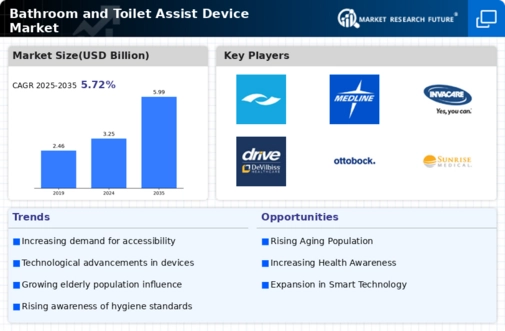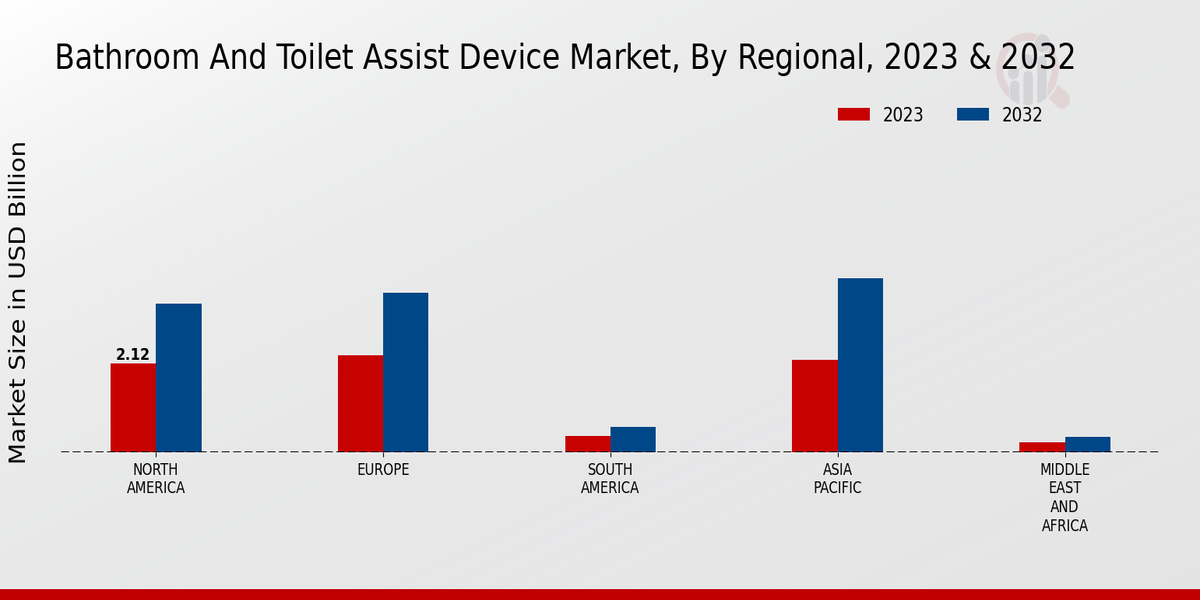Aging Population
The increasing global aging population significantly drives the Global Bathroom and Toilet Assist Device Market Industry. As individuals age, they often face mobility challenges, necessitating the use of assistive devices to maintain independence and safety in the bathroom. By 2024, the market is projected to reach 3.25 USD Billion, reflecting the growing demand for products designed to enhance accessibility for seniors. Countries with higher proportions of elderly citizens, such as Japan and Italy, showcase a pronounced need for these devices. This trend indicates a sustained growth trajectory, as the number of elderly individuals is expected to rise, further propelling market expansion.
Market Growth Projections
The Global Bathroom and Toilet Assist Device Market Industry is poised for substantial growth, with projections indicating a market size of 3.25 USD Billion in 2024 and an anticipated increase to 5.99 USD Billion by 2035. This growth trajectory suggests a compound annual growth rate of 5.72% from 2025 to 2035, reflecting the increasing demand for innovative and accessible bathroom solutions. Factors such as an aging population, rising health awareness, and government support are likely to contribute to this upward trend. The market's expansion is indicative of a broader societal shift towards inclusivity and accessibility, underscoring the importance of assistive devices in enhancing the quality of life for diverse populations.
Technological Advancements
Technological advancements in the design and functionality of bathroom and toilet assist devices are reshaping the Global Bathroom and Toilet Assist Device Market Industry. Innovations such as smart toilets, adjustable height features, and user-friendly designs enhance the usability of these devices for individuals with varying needs. For example, the integration of sensors and automated features in modern assistive devices not only improves user experience but also promotes safety. As these technologies continue to evolve, they are expected to attract a broader consumer base, thereby driving market growth. The anticipated compound annual growth rate of 5.72% from 2025 to 2035 underscores the potential impact of these advancements.
Government Initiatives and Funding
Government initiatives and funding aimed at improving accessibility for individuals with disabilities significantly influence the Global Bathroom and Toilet Assist Device Market Industry. Many countries are implementing policies that promote the adoption of assistive devices, providing financial support for individuals in need. For instance, various government programs offer subsidies for purchasing bathroom assistive devices, thereby reducing financial barriers. This support not only encourages the use of these devices but also raises awareness about their importance in enhancing quality of life. As a result, the market is likely to experience sustained growth, driven by these supportive measures and the increasing recognition of the need for accessible solutions.
Increased Incidence of Disabilities
The rising incidence of disabilities globally is a pivotal factor driving the Global Bathroom and Toilet Assist Device Market Industry. As the prevalence of conditions such as arthritis, stroke, and other mobility impairments increases, the demand for assistive devices that facilitate bathroom use is expected to grow correspondingly. This trend is particularly evident in regions with aging populations, where the need for specialized devices becomes more pronounced. The market's expansion is further supported by the increasing awareness of the importance of assistive technologies in improving the quality of life for individuals with disabilities. This growing recognition is likely to contribute to the market's upward trajectory in the coming years.
Rising Awareness of Health and Hygiene
Increased awareness regarding health and hygiene, particularly among vulnerable populations, is a crucial driver for the Global Bathroom and Toilet Assist Device Market Industry. The emphasis on personal hygiene, especially in healthcare settings, has led to a surge in demand for assistive devices that promote cleanliness and safety. For instance, hospitals and rehabilitation centers are increasingly adopting these devices to ensure patient comfort and prevent accidents. This heightened focus on hygiene is likely to contribute to the market's growth, with projections indicating a rise to 5.99 USD Billion by 2035. The correlation between hygiene awareness and assistive device usage suggests a robust future for this market.



 Source Primary Research, Secondary Research, Market Research Future Database and Analyst Review
Source Primary Research, Secondary Research, Market Research Future Database and Analyst Review 














